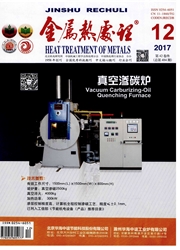

 中文摘要:
中文摘要:
对一种低碳试验钢分别采用淬火、回火、Q&P、深冷等不同工艺进行热处理,并借助落锤冲击试验机、扫描电镜、X射线衍射、透射电镜等手段对其冲击性能、断口形貌和显微组织进行研究。结果表明,深冷处理能使钢中残留奥氏体明显减少,但冲击吸收能量的变化不明显。经过Q-P处理可以显著提高残留奥氏体量,同时改善试验钢冲击性能。经过280℃×5 min回火处理后,残留奥氏体量虽有所降低,但冲击性能却有较大的提高。对低碳马氏体钢而言,可以通过Q-P处理提高残留奥氏体的热稳定性来改善其冲击性能,也可以通过低温回火处理促使ε过渡型碳化物的析出或者形成退火孪晶来提高其冲击性能。
 英文摘要:
英文摘要:
A low-carbon steel was treated by quenching, tempering, Q&P ( quenching and partitioning) process and cryogenic treatment respectively.The impact property, fracture morphology and microstructure of the tested steel were investigated with the help of drop weight impact testing machine, SEM ( scanning electron microscope) , XRD ( X-ray diffraction) and TEM ( transmission electron microscope) .The results show that the volume fraction of retained austenite of the tested steel decreases considerably after cryogenic treatment, but its impact property does not change obviously.However, after Q-P treatment, the volume fraction of retained austenite increases significantly and meanwhile the impact property is improved.Moreover, the impact property of the tested steel increases dramatically after tempered at 280℃for 5 min even though the volume fraction of retained austenite reduces slightly.Therefore, the impact property of low-carbon martensite steel can be improved by Q-P process which strengthens the stability of retained austenite and also by low temperature tempering which results inεcarbide precipitation or annealing twins formation.
 同期刊论文项目
同期刊论文项目
 同项目期刊论文
同项目期刊论文
 In situ X-ray diffraction study of martensitic transformation in austenitic stainless steel during c
In situ X-ray diffraction study of martensitic transformation in austenitic stainless steel during c icrostructure Development and Mechanical Properties of a Hot Stamped Low-carbon Advanced High Streng
icrostructure Development and Mechanical Properties of a Hot Stamped Low-carbon Advanced High Streng Deformation analysis of hot stamping tools by thermal–fluid-mechanical coupled approach based on MpC
Deformation analysis of hot stamping tools by thermal–fluid-mechanical coupled approach based on MpC Simulation of martensitic transformation of high strength and elongation steel by cellular automaton
Simulation of martensitic transformation of high strength and elongation steel by cellular automaton 期刊信息
期刊信息
